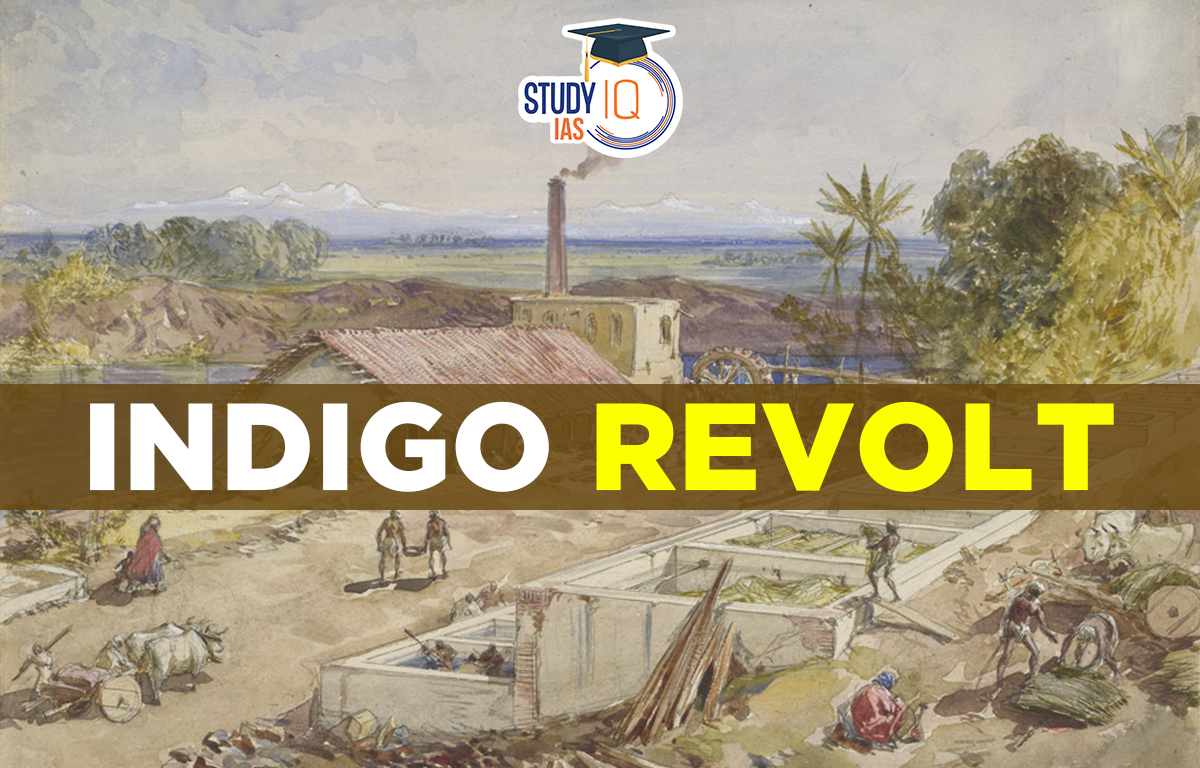Table of Contents
Indigo Revolt
The Indigo Revolt of 1859–60 in Bengal, India, was a peasant movement against the exploitative practices of Indigo planters. The tenants were forced to grow indigo, which was purchased from them at throwaway prices and processed in factories set up by indigo planters, almost all of whom were Europeans. The peasants were naturally enraged by this.
Read about: Revolt of 1857
Indigo Revolt Background
The 1770s saw the start of indigo cultivation in Bengal. Due to the demand for blue dye in Europe at this time, indigo was becoming more and more commercially profitable due to increasing demand caused by Industrial Revolution in Britain.
On their own lands, peasants were persuaded to plant indigo rather than food crops by indigo planters. They were offered loans at exorbitant interest rates. However, peasants were paid a very small percentage of the actual market price. This made indigo cultivation unprofitable for the planters. As a result, they were unable to repay the loans. The indigo planters forced the peasants to pay their debts by confiscating their lands, animals, bees, and other valuables.
Through a law passed in 1833, the planters were given complete discretion in how they handled the peasants. The zamindars backed the planters because they also stood to gain from indigo farming. Peasants revolted in response to these conditions.
Indigo Revolt in Bengal
Red is supposedly the colour of revolution but it can be blue at times. Thousands of ryots (peasants) in Bengal refused to grow indigo for the European planters (owners of land and indigo factories) during the summer of 1859. It was an act motivated by rage and unyielding resolve. One of the most significant peasant movements in Indian history was born out of it which was named the Indigo Revolt or Neel Bidroha.
The Indigo revolt started in the Bengal district of Nadia. In no time, it spread to other areas of Bengal such as Birbhum, Pabna, Kulna, and Murshidabad. Bengal has been growing indigo since the 18th century’s close. The Nij-abad and the Ryoti were the two main forms that were used to practise it. In the Nij, or “own,” system, the planter produced indigo on land under his direct control. In the Ryoti cultivation, the ryots grew indigo as agreed in a contract with the planters on their own grounds.
Indigo Revolt Leaders
The Indigo Revolt was led by Bishnu Biswas and Digambar Biswas who belonged to the Nadia district of Bengal. Later they were joined by peasant leaders from other parts of Bengal.
Indigo Revolt Methods used by Rebels
Some Indigo planters were beheaded following a public trial. Indigo depots were destroyed by the peasants using fire. Land records and debt records were burned. The zamindars were also a target of the peasants of the Indigo rebellions.
In most places, the revolt was non-violent. Peasants resorted to social boycotts of planters. Also, they adopted practices like non-payment of the debt and the zamindar’s rent.
Indigo Revolt Causes
On their own lands, peasants were persuaded to plant indigo rather than food crops by indigo planters. They were offered loans at exorbitant interest rates. However, peasants were paid a very small percentage of the actual market price. This made indigo cultivation unprofitable for the planters. As a result, they could not pay back the loans.
Indigo planters used coercive methods to extract their dues from the peasants, such as confiscating their lands, cattle, begar, etc. Planters were also supported by zamindars. Growing indigo rendered the soil infertile. It could not be used for the cultivation of food crops.
Indigo Revolt Consequences
- The Sepoy Mutiny of 1857 (or Revolt of 1857) had already made the British feel threatened, and they wanted to avoid another popular uprising. In many areas, Dist Magistrates allowed peasants to grow non Indigo crops.
- The government had to set up the Indigo Commission in 1860. Commission in its report was highly critical of practices adopted by planters. Soon Indigo cultivation stopped in Bengal. However, some planters moved to Bihar.
- The long-term consequence of the Indigo revolt was that it inspired the rebellion against the British indigo planters in 1817 that was led in the form of Champaran Satyagraha in Bihar.
- The Indigo Revolt also inspired important cultural developments like the writing of ‘Neel Darpan’ by Deenbandhu Mitra.
Indigo Revolt UPSC
Literature, music, and movies were all influenced by Neel Bidroha. Nil Darpan or the “Mirror of Indigo,” a play by Dinabandhu Mitra that was composed in the midst of the movement in 1859, is still regarded as a classic. It described the hardships, repression, and struggle faced by indigo cultivators.
The ryots endured deprivation, tyranny, dominance, and humiliation. But despite all of this, they continued to speak up. Their decision to avoid sowing indigo stayed steady throughout. Panjee Mulla, one of the ryots, said, “I would rather be killed with bullets than sow indigo,” which perfectly expresses how he feels.
Indigo Revolt became one of the greatest peasant movements that shook the colonial government. It paved the way for nationalist awakening among the peasants. As a result future movements like the Swadeshi Movement in Bengal, Champaran Satyagraha, Non-Cooperation Movement saw widespread peasant participation. The movement also highlighted the educated Indians and how Britishers used the concept of the Drain of Wealth.


 Important Lakes of India, State wise and...
Important Lakes of India, State wise and...
 Buddhism History, Origin, Sect, Councils...
Buddhism History, Origin, Sect, Councils...
 Andaman and Nicobar Islands, History, Cl...
Andaman and Nicobar Islands, History, Cl...





















